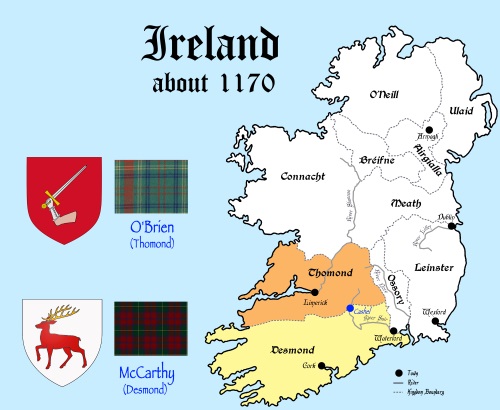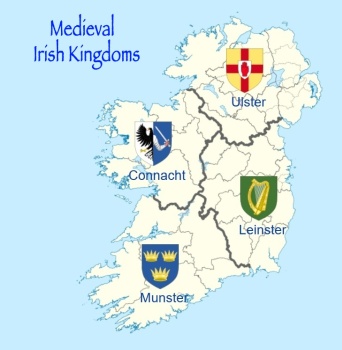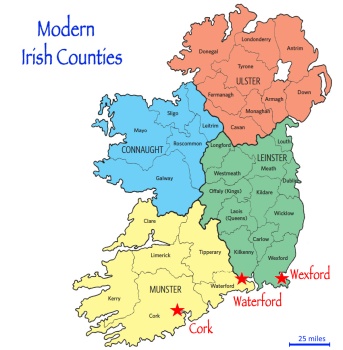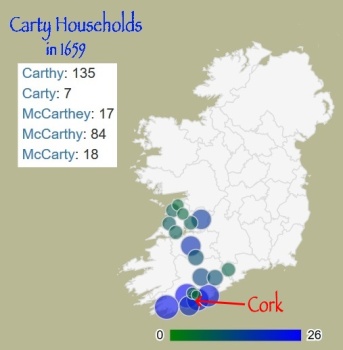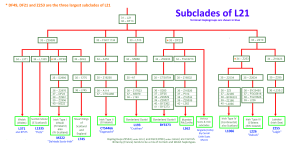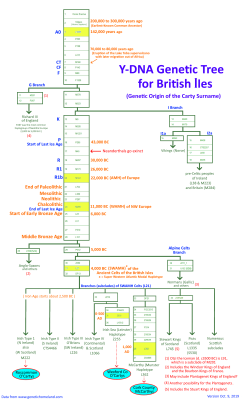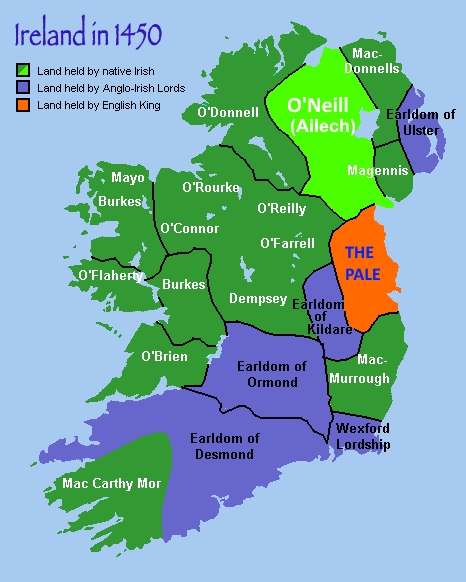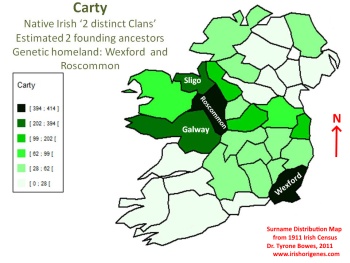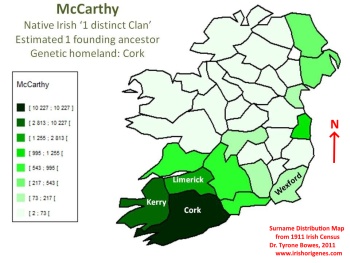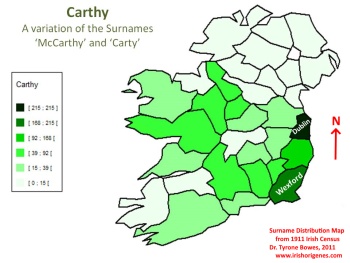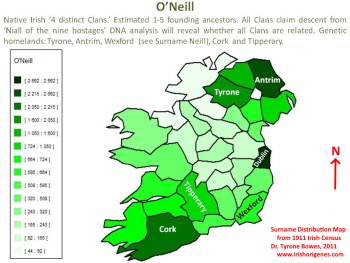|
APPENDIX 1:
IntroductionThe names Carty, McCarty and McCarthy originate from King Cárthaigh (d. 1045), who was one of the last members of the Eóganacht dynasty that ruled the Irish Kingdom of Munster from the 5th to 10th centuries. When a lesser king named Brian Boru (c.937-1014) in 977 wrested the crown of Munster from the Eóganachts, he founded the Ó Briain (O'Brien) dynasty, which ruled parts of Munster for the next 500 years. King Brian also subjegated the Kingdoms of Leinster, Ulster and Connacht to become the High King of Ireland, until he was killed fighting the Norse (Viking) overlords of Dublin at the Battle of Clontarf. Despite the ascendancy of the O'Briens, Cárthaigh's family kept control of Cashel, a land in east Munster that corresponds today to County Tipperary. Cárthaigh perished in 1045 in a house fire set by his enemies, afterwhich he was succeeded by his son Muireadhach Mac Cárthaigh, whose name literally means "Muireadhach, son of Cárthaigh". When Muireadhach died in 1092, he was succeeded by his sons Tadhg (d. 1123) and Cormac (d. 1138), both of whom took Mac Cárthaigh (McCarthy) as their surname. Cashel, and specifically a castle there called the "Rock of Cashel", is the historic seat of the Kings of Munster. This put Cárthaigh's family, as rulers of Cashel, in conflict with the O'Brien rulers of Munster. Their conflict continued until 1118 when the Treaty of Glanmire divided Munster into two kingdoms - Ormond, from Tuadh-Mhumhain, which means "North Munster"; and Desmond, from Deas-Mhumhain, which means "South Munster". The O'Briens received Ormond, and Cárthaigh's grandson Tadhg Mac Cárthaigh became King of Desmond. The McCarthy dynasty that Tadhg, and his brother and successor Cormac founded, went on to rule Desmond for almost 500 more years. Their rule finally ended in 1596 when the death of the last king led to the eventual partitioning of the kingdom into Counties Cork and Kerry. Today the arms and tartan of the McCarthy clan, and those commonly adopted by by families bearing the Carty and McCarty surnames, are those once worn by the McCarthy kings of Desmond. Economist William Petty's 1659 census of Ireland, which was published in 1939 by Séamus Pender, is actually a list of Irish households taxed by the British in the final years of Oliver Cromwell's reign. Although it shows variations of the Cárthaigh surname spread across Cork, Limerick and Clare counties in central Munster, the name was probably also very common in adjacent parts of central Ireland that were not included in Pender's Census. The surname likely developed when many Irish families with roots in South Munster identified themselves in the British tax lists as Ó Cárthaigh, which translates as a "descendant of Cárthaigh". Many subsequently dropped the Ó prefix, and anglicised Cárthaigh to Carty. It has been suggested that some proud Irish immigrants to America and/or their descendants may have later changed Carty to McCarty in the mistaken belief that they were restoring their name back to its original Irish form. And then there were other Irish-Americans who changed their name from Carty to Carter or Cartier to hide the fact that they were Irish.
Celtic Haplogroups of IrelandHaplogroups are genetic variations that genealogists use to characterize and identify groups of people who share a common ancestor. The same can be said of haplotypes, which represent the building blocks of haplogroups. Thus, haplogroups may contain one or more haplotypes. Several haplogroups are found in the genetic homeland of south Ireland that the Carty family comes from (Counties Cork, Waterford and Wexford). Because the terminology tends to get a bit confusing, a "Short Introduction to Haplotypes" is provided in Appendix 2. For those who know what halpotypes and haplogroups are, please read on. Below is an example of five Irish haplogroups that are documented in the "McCarthy Surname Project" on the "Family Tree DNA website" (McCarthy, 2018). Also shown are the SNPs (i.e., genetic mutations) that identify the defining haplotype of each haplogroup. Most importantly, these haplogroups characterize groups of people living in specific geographic regions of Ireland, from ancient times right up to the modern era. This means that modern members of each haplogroup, irregardless of where they live today, probably share a common ancestry originating in the region that correlates to their haplogroup. Some of the families belonging to these haplogroups bear the Carty surname, or one of its variations.
If we go all the way back to the Stone Age, members of the above haplogroups share a common ancestor who probably lived in the steppes of Russia (Caspain Sea region) around 13,000 years ago, and whose descendants migrated into western Europe in ancient times. His Y-DNA contained the "Western Atlantic Modal Haplotype (WAMH)" that is characterized by the SNP M269 mutation, and it is found today in most men of northwestern European ancestry. This WAMH ancestor passed on his M269 mutation (along with the WAM Haplotype) to his male descendants, one of whom, thousands of years later during the mid- to late-Bronze Age (4,000 to 5,000 B.C.), developed the L21 mutation that characterizes the so-called "Super Western Atlantic Modal Haplotype (SWAMH)". SNP L21 is associated with the ancient Celts who populated the British Iles, and the Britanny region of France. The Irish DNA map and Y-DNA genetic tree shown below illustrate some of these concepts (click each for a more detailed view).
Genetic Genealogy of the Carty SurnameBecause the Carty surname and its variations are named after King Cárthaigh of Cashel, he is an eponym. Cárthaigh is also believed to have been a member of the L21 haplogroup, and to have carried the SNP ZS4606 genetic mutation, which is downstream of L21, and was passed on, from father to son, to Cárthaigh's direct male descendants (McCarthy, 2018). Therefore descendants of Cárthaigh in the paternal line should also carry the ZS4606 mutation, and/or any mutations of it, such as the closest-known downstream mutations SNP A5813 and SNP ZS4598. However, only about one in three McCarthys actually test positive for ZS4606, or its mutations (McCarthy, 2018). This indicates that most McCarthys do not descend in the male line from Cárthaigh, or any other of the McCarthy kings of Desmond. Even fewer of those with the Carty/McCarty surname have been found to descend in the male line from the eponymous Cárthaigh. However, descent in the female line is still possible, albeit much more difficult to document. James Carty of Essex, Vermont and his male descendants belong to the Irish Sea (Leinster) Y-DNA haplogroup. This means they do not carry the ZS4606 mutation of Clan McCarthy, nor do they carry any of its downstream derivatives. Instead they carry both the SNP Z255 mutation, and its immediate downstream derivative SNP L159.2 (S169.1). These mutations are widespread among families of Irish farmers that have lived for generations in the coastal region of southeastern Ireland (such as the Byrne, Carty, Doyle and Murphy families). They are in fact thought to have originated 1,500 to 2,000 years ago in or near the Medieval Viking settlement of Wexford that in 1169 became part of the Kingdom of Leinster. Because the ZS4606 marker of Clan McCarthy dates to the lifetime of King Cárthaigh (d. 1045), it is about 1,000 years old, which means the Irish Sea Haplotype (Z255) evolved long before King Cárthaigh was even born. The Irish Sea Haplotype is thought to indicate descent from the same family as the chieftans, and later Kings of Leinster, who in 1169 came to rule Wexford. Irregardless of whether or not this is true, the Irish Sea (Leinster) and the Clan McCarthy Haplogroups (Munster) have different origins. The Carty surname in modern times is very common in County Wexford. Also the Irish Sea Haplotype (Z255) is well represented among the Carty of families in southeastern Ireland (McCarthy, 2018, see R-L21 Groups E1 & E2). It is generally believed that the Wexford surname was originally The Carty surname is also very common in Counties Roscommon and Sligo in the northern Irish province (former kingdom) of Connacht. However, many of these Cartys belong to the Irish Type I (M222) Haplogroup that is characteristic of the Connacht Province (McCarthy, 2018). It is generally thought that these Cartys are a sept of the O'Rourke Clan, with an entirely separate origin from either the McCarthys/MacCarthys of Munster, or the Cartys of County Wexford in Leinster. Ua Carty is thought to be the original form of the surname for the Connacht branch of the family. The Ua prefix more or less means a "descendant of", similar to the meaning of the Ó prefix, which may be a different dialect of south Ireland. Ua Carty in time was probably simplified to O'Carty, and many families later anglicized their last name during British rule of the 17th through 19th centuries by dropping the O' to come up with Carty.
Origin of the Neal SurnameJames Carty married Lizzie Neale, and her maiden name in its original, ancestral form was probably O'Neill, or something similar. Her surname comes from King Niall Glúndub (d. 919) of Ailech, who ruled a part of northern Ireland that coresponds today to parts of Counties Donegal, Londonderry and Tyrone (see map above and right). Niall went on to found the O'Neill dynasty in 916 when he became High King of Ireland, but his rule was cut short when he was killed fighting the Vikings. His son Muirchertach (d. 943) was another king of Ailech, and he added to his name the suffix Mac Néill, which means "son of Niall". Then Niall's grandson Domnall (d. 980), like Niall a High King, used Ua Néill, which means a "descendant of Neill". Other descendants who ended up in south Ireland may have used Ó Néill, which has the same meaning. These became the surnames for many of the subsequent kings of Ailech, as well as others claiming descent from Niall. The name evolved further when some dropped the Ua/Ó, and anglicized Neill to Neal.
REFERENCES:
|
 Origin of the Carty surname, arms and tartan
Origin of the Carty surname, arms and tartan 

